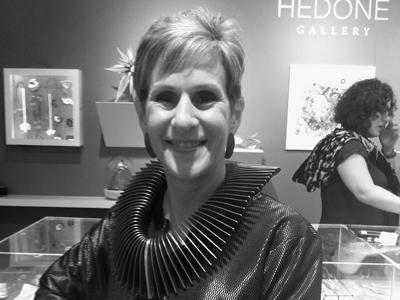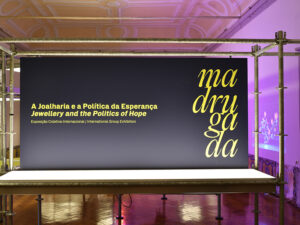This is the third of five interviews with the honorees. (Read the interview with winner MJ Tyson
here. The interview with finalist Junmin Bae is here.)AJF’s Young Artist Award acknowledges promise, innovation, and individuality, advancing the careers of rising artists. The competition was open to makers of wearable art age 35 and under who are not currently enrolled in a professional training program. Judging was based on originality, depth of concept, and quality of craftsmanship. This year’s jurors were curator Barbara Paris Gifford, historian Toni Greenbaum, and Chinese artist Bifei Cao, the winner of the 2018 Artist Award. The planned exhibition of the winner’s and finalists’ work, slated for display in Platina’s booth at Schmuck, unfortunately didn’t take place because of the cancellation of the Internationale Handwerksmesse this year due to the global coronavirus outbreak.

Bonnie Levine: Congratulations on being one of the five finalists of the 2020 Artist Award competition—that’s quite an accomplishment! Please introduce yourself to our readers. How did you become interested in jewelry, and what inspires your work?
Lore Langendries: I call myself an artistic maker active in the fields of contemporary jewelry and also objects. “Artist” seems too conceptual, while “designer” is situated too much in the thinking process and gives, in my opinion, too little focus on the actual physical contact between the maker and the artifact being made, the material.
I received my master’s degree in arts from PXL-MAD, in Hasselt, Belgium, in 2010, and have had a doctorate in the arts since 2015. My PhD played and still plays a significant part in my work and myself as an individual. The PhD was an artistic research in reproduction: a fusion of natural materials, mechanical treatment, and the human touch. In other words: Handling a computer-controlled industrial technique like laser cutting via a craftsmanlike way of thinking and working, creating individual pieces within families. Here’s a stop-motion video of the process from YouTube:
I’ve always had a huge interest in the interaction between manual and mechanical, balancing between the unique and the serial, with a particular focus on the tactile and physical aspects of making and the created object, the behavior and qualities of materials, digital technology, and my own subjective and intuitive role as a creator. Central to my work is the circle as a pure geometrical form that allows the essence and beauty of various materials to show through in their most elementary form. In a playful, experimental approach, my work almost always arises from a fascination for materials and their behavior. Materials are used as active agents in the design and making process—the material is subject and matter. Since the time of my research, I’ve reserved the main focus for animal hides, and I keep on exploring and playing with different aspects of that material today.

Besides finding inspiration in materials and their properties, I am bowled over by the work of Kate MccGwire, Christien Meindertsma, Nick Cave, Studio Maarten Kolk & Guus Kusters, Idiots, Alexander McQueen, Berlinde De Bruyckere, Damien Hirst, Brancusi, and Jan Fabre. Besides them, I think my vision, my identity, and my interests—and also appreciation and admiration for other artists and their skills—is visible in my private collection of jewelry by Marc Monzò, Gésine Hackenberg, Christian Metzner, Herman Hermsen, Märta Mattsson, Tine De Ruysser, Céline Sylvester, Pauwels & Spaenjers, Akiko Kurihara, Maryvonne Wellen, Phylicia Gilijamse, Mieke Dierckx, Melina Lindroos, and Davy Vanderheyden [shown above].
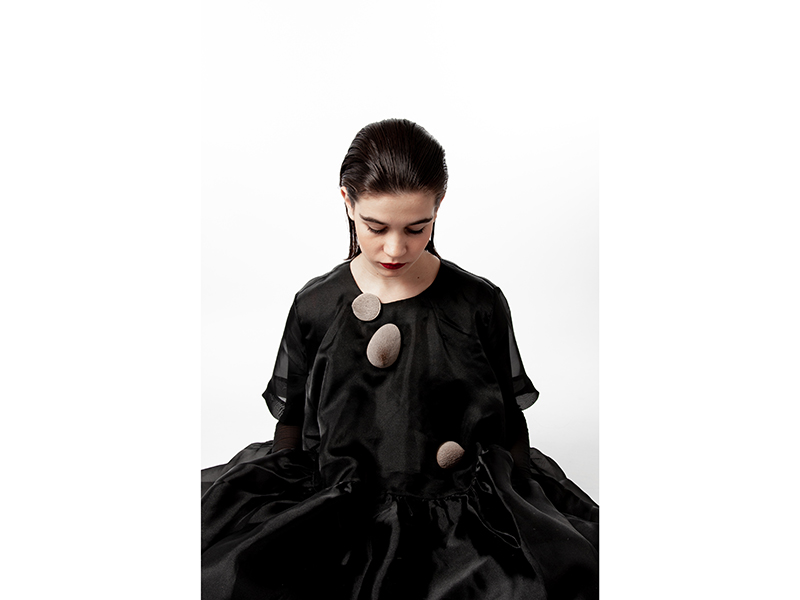
Tell us about the work you applied with.
Lore Langendries: The Hide, the Fragment series (started in 2018) is a group of brooches that portrays my way of working over the last years. Animal hides vary in structure, hair growth, hair direction, and skin thickness. Some fragments are rare and not reproducible, or impossible to imitate, like a cowlick, for example. These fragments and—at the end—wearable brooches are unique. In the early stage of my work I only used these unique fragments because these were the parts that were thrown away in industry due to their irregularity, and were in my work the most important. (I use springbok, roe deer, cow, or calf—all hides are byproducts of the meat industry and the animals are not bred for their skins, so I’m not using fur!) By using minimal geometrical shapes I could focus on the particular hide, on the natural direction of the fur, and specific details, similar to a photographic image in which a particular subject is defined, creating a new reality. Focusing on hidden details doesn’t reveal what we can vaguely see already; instead it reveals new structures of matter.
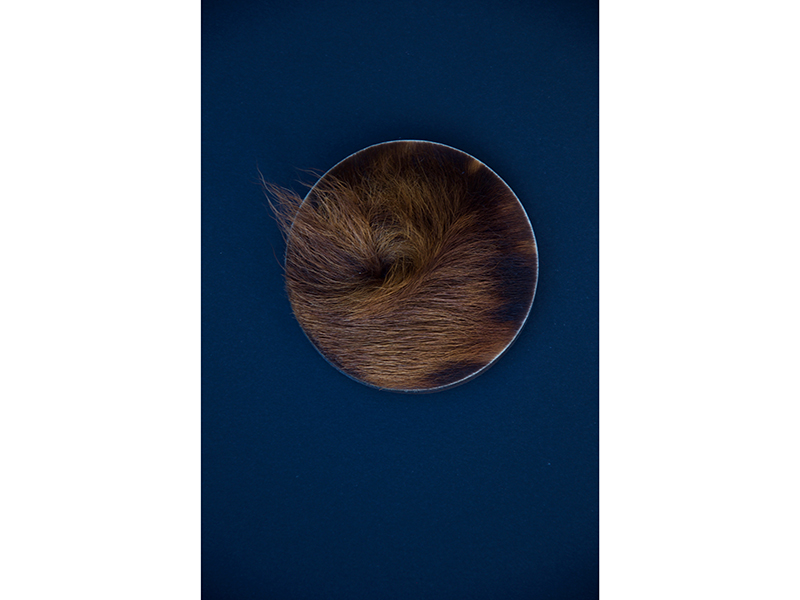
For the parts of the various animal hides that were less irregular or unique, I started finding ways to make them more unique and transformed them into individual characters by adding eyes and mouths or decorative and more abstract additions.

So with Hide, the Fragment I was presenting a new phase in my work—a focus on the fragment. Hide, the Fragment reveals or conceals, depending on how close it is to your skin. Does the fragment still evoke associations with the animal from which it originates, or does the pattern or shape elicit new references? As in my earlier brooches, I was selecting specific parts without adding or removing something. Now I’m adding much more and my involvement is again bigger.
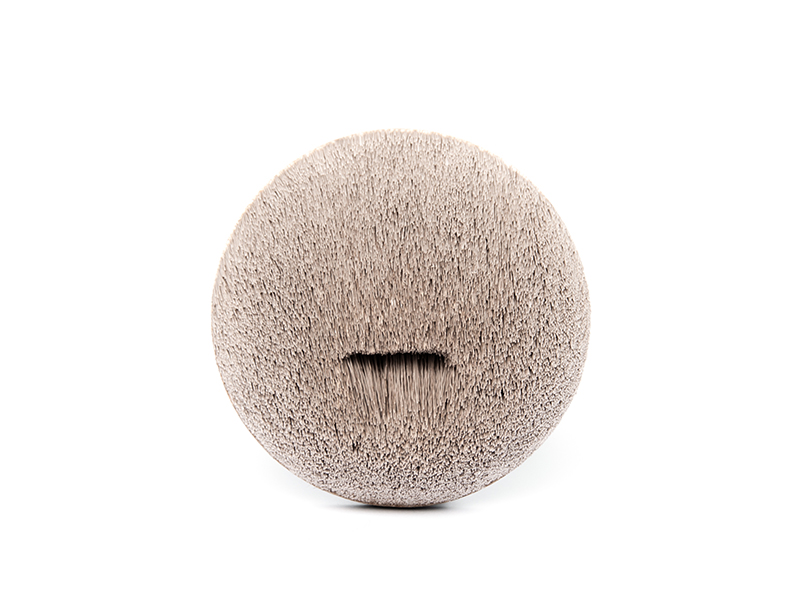
By cutting, shaving, and trimming, the material is transformed and in some cases unrecognizable. Some fragments evoke associations from which they originate, others elicit new references by shape or pattern. Pieces look like solid rocks rounded by the action of nature, but feel like soft cushions that stimulate our sense touch. Others remind us of our teddy bears from our childhood or look like African masks. Hiding identity and creating a new one.
The hairy pieces, worn on the body, create mixed feelings. On the one hand, it’s unattractive wearing a hairy object; on the other, it’s attractive, and stroking becomes an automatic reaction. Our human instinct to stroke, touch, and care for hairy things and other objects around us is in danger.
What excites you about the art jewelry field?
Lore Langendries: During my studies I never wanted to be part if this world! And all of a sudden I’m completely in it! Once you’re represented by some galleries, taking part in international exhibitions, and other artists worldwide are becoming friends, it’s such an inspiring, energetic, and special field. Small but big in enthusiasm.
I like to be active in other fields outside the jewelry field, as well. Collaborations can broaden your view, create other opportunities, and get you out of your comfort zone. These collaborations inspire and can stimulate my jewelry as well. Here are my most important collaborations:
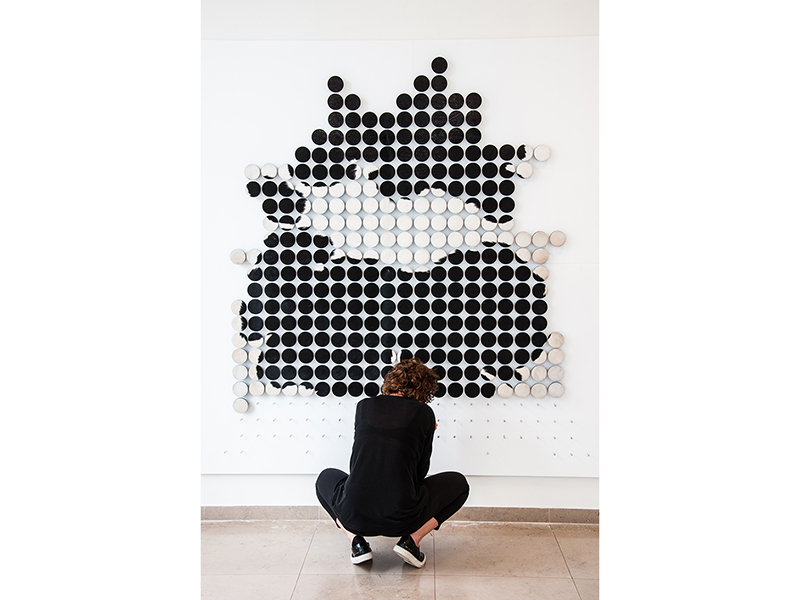
Holstein LL 1401 (2016). This project was born from an unusual combination of a grid comprising identical circles, a natural cowhide, and reproductive laser-cutting technology. Variation in skin thickness, hair growth, and the color of the hide transformed the automatically produced circles into individual artifacts: 366 brooches. In 2016 I did a collaboration with the wall installation together with Le Chaperon Unlimited,[1] an online gallery from Belgium.
For one year we traveled with the Holstein installation through Belgium and the Netherlands to search for people who wanted a piece of the whole and to become part of our “Holstein Family.” During this year we’ve introduced the audience to a brooch a day on our social media by sharing an image, memory, or quote. Each Holstein brooch found a new home with a stranger slowly but surely, and started a new life. Every piece of the wall got a new future and face—because every brooch that was sold was replaced by a picture of its new owner, put on the wall, offline as well as online. A true Holstein family was born along the way and connected to each other by one cowhide. The project was all about connecting people, online and offline, with only one common divider, one small circle that holds and connects them together. What started off as a wall installation of 366 individual brooches transformed to a Holstein family after 366 days, and the group was physically reunited in a closing event that brought all the “family members” together!
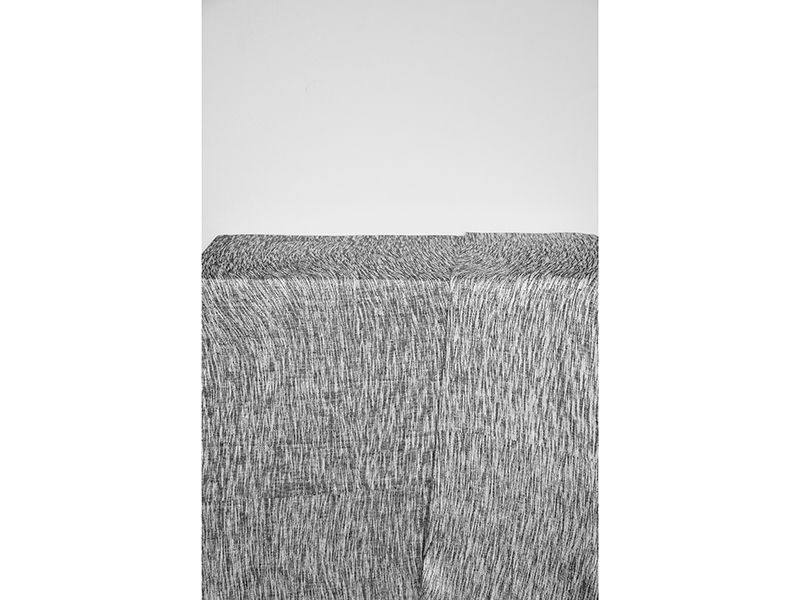
Tableskin Verilin (2017). I collaborated with Verilin, a Belgian luxury linen manufacturer, to create a tablecloth and bed linen: Tableskin and Second Skin. Still emerging from my jewelry, the idea came to transfer the natural animal hides and their properties to a new natural carrier. Tableskin played with the attraction and repulsion of hair at the table. The character and tactile appeal of the material was literally portrayed. A digital image of a roe deer hide was transformed into a natural linen fabric thanks to the combination of Verilin’s tradition, craftsmanship, and innovation. The matching napkins derived from a close-up of a cowlick from the same hide. Where you could doubt with the tablecloth, there is no doubt with the napkins. You’re wiping your mouth with hair. Tableskin received the Design-Led Crafts Award of the Henry Van de Velde Awards 2017 of Flanders DC for Design in Belgium.
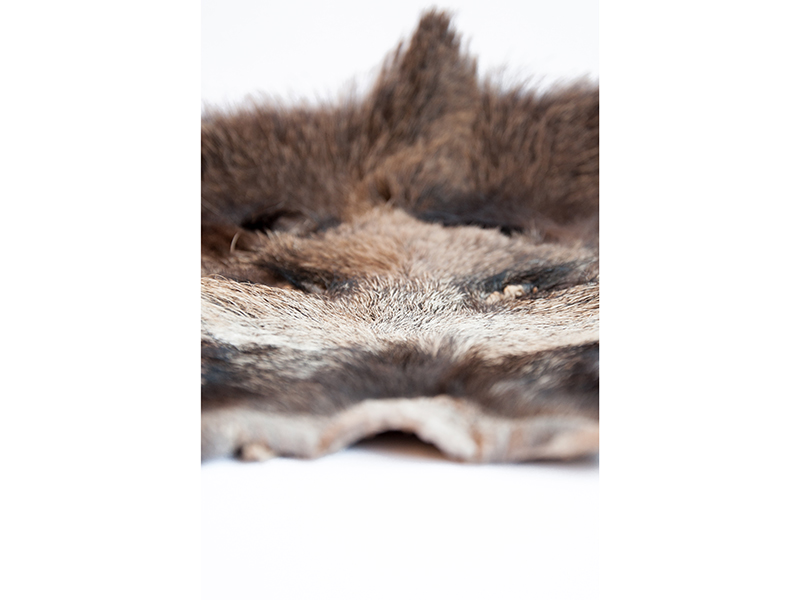
WILD (2020). WILD is a new project still in its early stages. The project starts from a healthy ecosystem principle and tries to find an artistic solution for the overpopulation of wild boar in Belgian forests. How can we use the wild boar and its original habitat as raw materials? And how can we adjust the processing and editing to one another without making an impact on that habitat? The project is a collaboration with Rayah Wauters, from Atelier Nauwau. Our similar approach to natural materials brought us together. Wauters is an artistic maker creating poetic archetypes in wood. The shape from trees is preserved, traces and fractures are emphasized by minor interventions.
So in WILD we want to achieve a harmony between biotope and organism, between tree and animal, wood and skin. Today we’re starting with our first experiments.[2]
Any frustrations that you see or have experienced?
Lore Langendries: Frustrations no. I don’t think I have the right to criticize the field, but what’s remarkable is that no one is paying attention to the packaging of our work. We make our pieces with heart, soul, and hands, so why do we not box them nicely for the ones who are buying? Maybe artists do pay attention to their packaging, but I’ve never really seen it or talked about it. Maybe we could talk about it more and show it as well. Put on an exhibition showing the packaging, or do a quiz: which package belongs to which piece? In my opinion, packaging a piece nicely when it’s finished is satisfying and also shows a form of respect to our work. When objects, jewelry, or other artworks are placed in a well thought-out packaging, it gives the owner so much more pleasure and it even stimulates care for the piece and the value it will have in the owner’s life.
More generally: The world becoming more and more dominated by technology and the digital virtual image ensures an increasing separation from the emotional and physical aspect of artifacts. Thanks to the internet we’re all visually and virtually connected, but not physically. We’re falling out of touch, not only touch with the objects, but with the intelligence they embody: the empathy that’s bound up in tangible things. To embrace this idea and to embrace touch and carefulness, every piece of mine made since the end of 2019 comes packed in a black box with a short text and a comb, to encourage cherishing and cuddling without apps or upgrades.

Where do you think the art jewelry field is going? Do you see new and exciting trends?
Lore Langendries: Ten years ago, when I received my master’s degree, serial work was not accepted and not offered by galleries as it is nowadays. Because the audience is such a small group of people wanting to wear these pieces, but also because these types of pieces are affordable, I think galleries had to rethink this. I’m not complaining. If it’s good once, why can’t it be good twice?
On the other hand, not many artists like to make pieces more than once, although, as in my work, they will always vary a little. But I like the repetitive and almost meditative aspect of repeating a handling and improving the way something is made. According to my mom, I was an easy and happy child, always playing outside, crafting and creating my own “factory” where the production process already played an important role in what I did!
If you could write a master plan for your practice, where would you like to be five years from now?
Lore Langendries: I don’t like to write master plans, and if so, what is a master plan? A goal you can work toward and bit by bit adjust the plan concerning the achieved challenges. In the world and situation in which we live today … this master plan would probably be ready to throw in the trash.
But in five years it would be nice to still work together with the same galleries as I do today, spontaneously broadening my network, making new work that I want to make, developing better skills, doing several collaborations, and exploring the world together with my pieces.
Of course I would like to become better and better, everybody wants more and more, our human instinct is always to long for things we don’t have or haven’t achieved yet. So, yes, becoming good, perfect, at things I want to do! I know my first goal was to sell a piece I made myself, next to be represented by a well-known gallery, next to be selected for Schmuck, next to have an exhibition in a well-known gallery. So today I would say: maybe a solo show, preceded by an artist residency to create work with locally sourced animal hides. I wish to create more and bigger wall pieces as well.
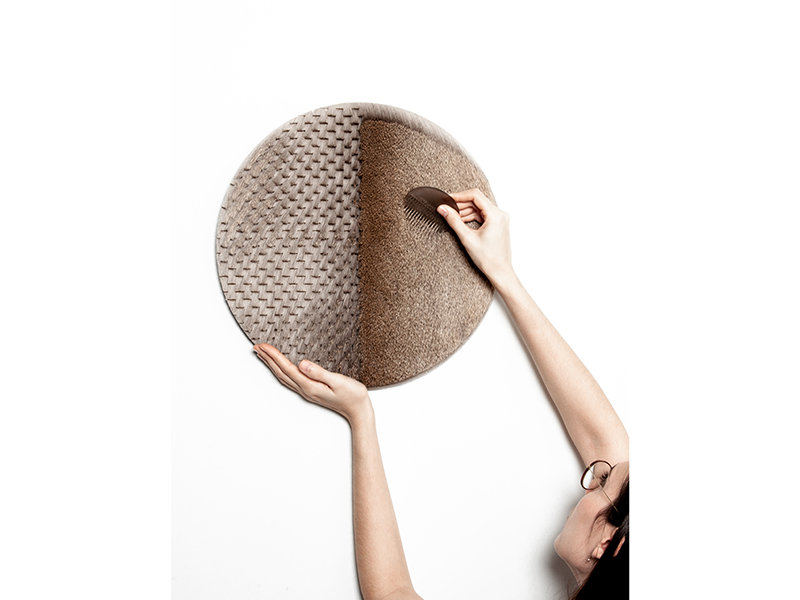
What does being a finalist mean for you? Do you think it will influence you going forward?
Lore Langendries: Well, I think this a bit difficult to answer as we’ve all been locked down in our homes since March… But of course being a finalist is an energy boost and the appreciation gives me the courage to go further and keep on developing myself. Although I miss the life and physical exposure of my work due to COVID-19, I think this can only stimulate me to expand my professional contacts with the field.
I don’t want to expect too much. It only can get better. When we had the AJF Live interview on April 1, over 90 people attended the live chat and studio visit. I’m really happy and grateful for this opportunity and look forward to the next ones…
Reader, watch AJF Live: Lore Langendries to see the artist’s studio, see her handling some of her work, and learn more about her practice.

These gentle jewels take the form of brooches, whose surfaces are articulated through the natural growth patterns of animal fur. It is brilliant how the maker obtains ecological clarity with such simple means. —Toni Greenbaum, Young Artist Award juror
The series is a great deductive design that created simple geometric forms while building up a textured surface. All surfaces of each piece aroused a similarity and consistence, but slight shifting between each other created stillness. —Bifei Cao, Young Artist Award juror
Surprisingly simple and stunning. Innovative, visually consuming, and slightly off-balancing. —Barbara Gifford, Young Artist Award juror
[1] https://www.lechaperonunlimited.com.
[2] You can follow them on Instagram @in.wildland.
